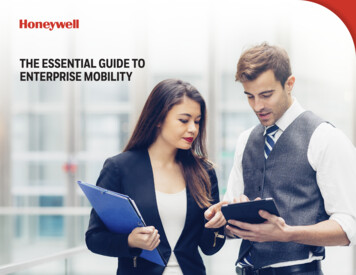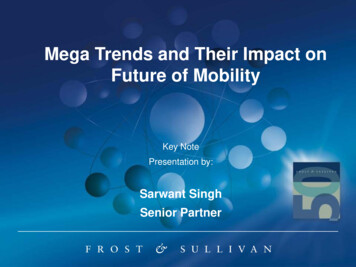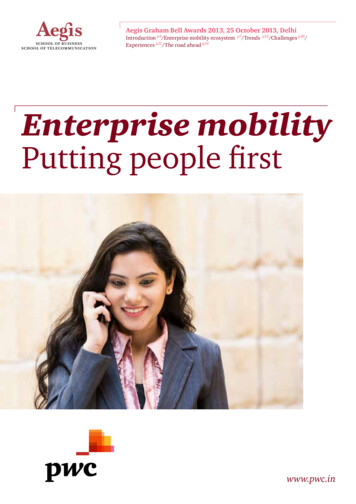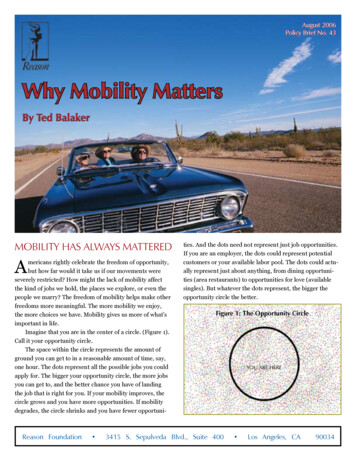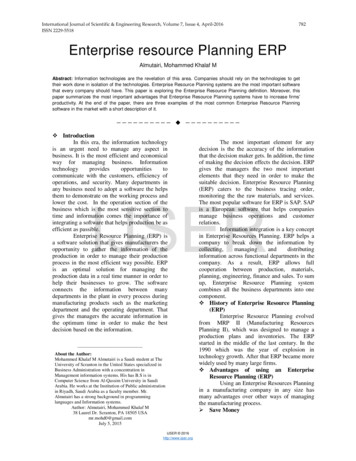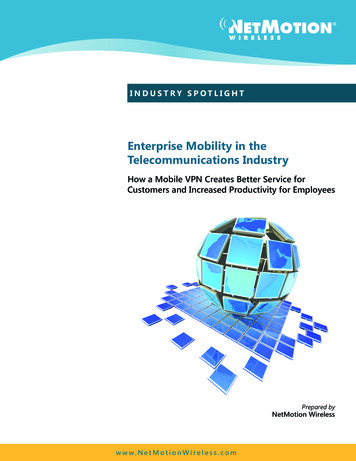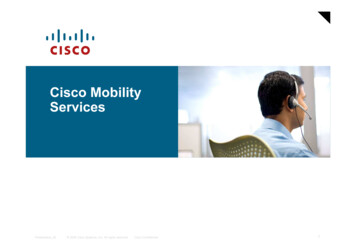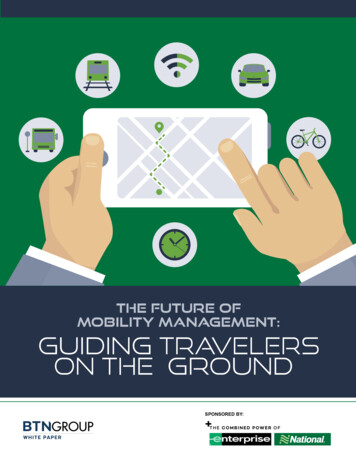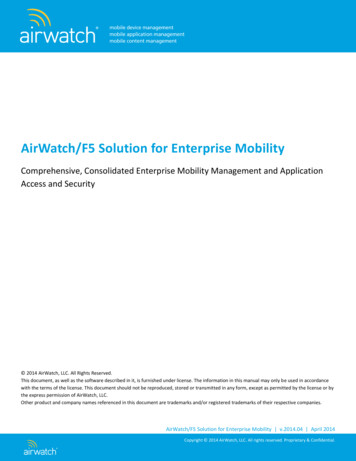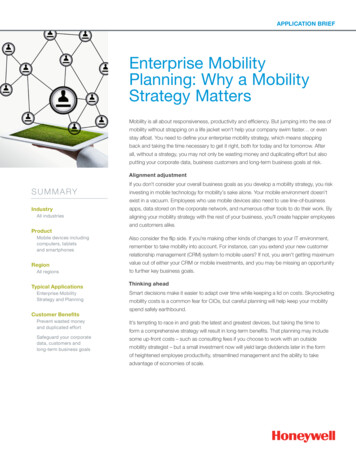
Transcription
APPLICATION BRIEFEnterprise MobilityPlanning: Why a MobilityStrategy MattersMobility is all about responsiveness, productivity and efficiency. But jumping into the sea ofmobility without strapping on a life jacket won’t help your company swim faster or evenstay afloat. You need to define your enterprise mobility strategy, which means steppingback and taking the time necessary to get it right, both for today and for tomorrow. Afterall, without a strategy, you may not only be wasting money and duplicating effort but alsoputting your corporate data, business customers and long-term business goals at risk.Alignment adjustmentSUMMARYIf you don’t consider your overall business goals as you develop a mobility strategy, you riskinvesting in mobile technology for mobility’s sake alone. Your mobile environment doesn’texist in a vacuum. Employees who use mobile devices also need to use line-of-businessIndustryAll industriesProductMobile devices includingcomputers, tabletsand smartphonesRegionAll regionsTypical ApplicationsEnterprise MobilityStrategy and PlanningCustomer BenefitsPrevent wasted moneyand duplicated effortSafeguard your corporatedata, customers andlong-term business goalsapps, data stored on the corporate network, and numerous other tools to do their work. Byaligning your mobility strategy with the rest of your business, you’ll create happier employeesand customers alike.Also consider the flip side. If you’re making other kinds of changes to your IT environment,remember to take mobility into account. For instance, can you extend your new customerrelationship management (CRM) system to mobile users? If not, you aren’t getting maximumvalue out of either your CRM or mobile investments, and you may be missing an opportunityto further key business goals.Thinking aheadSmart decisions make it easier to adapt over time while keeping a lid on costs. Skyrocketingmobility costs is a common fear for CIOs, but careful planning will help keep your mobilityspend safely earthbound.It’s tempting to race in and grab the latest and greatest devices, but taking the time toform a comprehensive strategy will result in long-term benefits. That planning may includesome up-front costs – such as consulting fees if you choose to work with an outsidemobility strategist – but a small investment now will yield large dividends later in the formof heightened employee productivity, streamlined management and the ability to takeadvantage of economies of scale.
APPLICATION BRIEFMap your path: How to establish the right strategypopularity, and it can spare you some difficult decisions, but itGone are the days when mobility involved simply choosing aalso presents a whole series of considerations: How expensive willstandardized device. Today, you have to think about not justit be to support a BYOD program? How does our BYOD programdevices, but apps, data, storage, management (of devices, apps,affect our ability to provide custom apps? Should we use stipendscontent and telecom expenses), and support. Each plays anto help users acquire their own devices and plans? Are weintegral part of a successful mobility strategy.opening ourselves up to potential legal ramifications? Do we needadditional security software to help mitigate risks?Take stockBefore you start to make purchasing decisions, you need a trueunderstanding of your current state, including your applicationDownload Honeywell’sBYOD policy template for:architecture and your business requirements. Without knowingwhat you have, you won’t be able to make sound financialdecisions about what you need. Analyze your infrastructure andprocesses and consider how you’d like to translate them into themobile world. Think about your existing technology investmentsand those that could apply to your mobile strategy.Of course, it’s also important to evaluate your competition andwhat’s going on in your industry in terms of enterprise mobility. Is acool app from one of your competitors leaching away your marketshare? How can you capture the interest of their customers and A comprehensive list of key elements toinclude in your policy Tips on stronger security for your mobileenterprise Guidance on how a BYOD policy can save youtime and money Ways to realize the full potential of your BYODenvironmentmake sure to keep your own? Knowing what other companies aredoing – seeing what works and, perhaps more importantly, whatdoesn’t work – can help shape your own mobility goals.If you opt for a corporate, non-BYOD approach, you’ll need todetermine the right platform and recognize which devices straddleGrassroots supportthe fine line between cost-effective use of company resourcesWhen it comes to establishing a mobility strategy, you can’t go itand user acceptability. After all, if employees don’t like the devicesalone. Soliciting buy-in from key stakeholders results in a largeryou choose, they won’t use them, which would be a waste of time,pool of ideas, greater adoption and less frustration later. Getinput from all angles by forming a cross-functional team to helpenergy and budget. Putting into employees’ hands devices that tieinto your existing infrastructure, run necessary apps and heightendetermine what makes your business tick. Working togetherproductivity will have a major influence on adoption.will also give you a stronger sense of the specific issues andAn app a dayopportunities that your mobile strategy should address. Have yourteam identify all the ways that different roles in your workforcecurrently use mobility, and explore other areas that are ripe forenhancement. Together, you’ll get a complete view of how manyMore and more, software companies are investing in mobileversions of their enterprise apps, but that doesn’t necessarilymean those apps are right for you. Having native compatibilitybetween desktop and mobile devices seems logical, but you haveways mobility could play a positive role in your company’s future.to make sure that those mobile apps meet your company’s needs.Divisive devicesIt may be that other off-the-shelf apps make more sense, or youIt’s a given that stakeholders will have strong opinions aboutwhich devices are right for them. And with new devices floodingmay want to develop your own. In a recent survey of IT executives, 68% reported that theirthe market every year, it can be a balancing act to stay currentorganizations are looking to offer applications for mobile deviceswithout breaking the bank. One of the most critical decisionsfocused on productivity over the next 24 months.that many companies have to make is which mobile platformto choose. Establishing a standardized platform helps otherelements – such as apps and support – fall into place with minimalhassle. The bring-your-own-device (BYOD) model is growing in In the same survey, 84% of IT executives state that having anenterprise app store that delivers internal apps is somewhat orhighly important.
APPLICATION BRIEFWould it work best to use the cloud to serve up your apps?It’s policyDo you plan to virtualize them? Do you want to provide for aPolicy can be a dirty word in the IT realm, but putting the right policiesrange of platforms? Knowing the answers to these questionsin place can be critical to successful enterprise mobility. They canwill help you formulate amake a difference in ease of use, cost, IT control, security the listmobile app strategy thatgoes on. Make sure you’re clear on your policy goals because it’swill serve you well botheasy to lose sight of the fact that you are trying to protect content,now and in the future.and find yourself concentrating on cost savings instead.Protect the crown jewels Decide on relevant acceptable-use policies to determineIf desktop securitywhich apps are approved and which are blacklisted.breaches make you Make certain that sensitive data is properly encryptedbreathe into a bag, imagineand available only to those who should have it.the risks involved inputting corporate data ondevices that employeesDid you know?take on business trips,According to TheStreet,within the next year,corporate IT departmentsthat have not enableda diverse population ofdevices and end-userchoices through emphasison manageability, policyenforcement and securityevaluations will becomehopelessly outmoded andstruggle to function.out to lunch and even onvacations. Safeguardingthose devices – and thedata that’s stored onthem – should be amongyour highest priorities.Here’s the good news:Devices and mobilesoftware apps now include Do everything you can to ensure that your devicesdon’t provide an open door to your corporate data.The more you lock down your devices, apps and content, the lessfreedom your employees have. While slowing down employees toomuch can have a negative effect on their productivity, making themthink before barreling ahead in an insecure direction can be worth asmall hassle. But try to avoid presenting policy hurdles that are toobig, because they tend to result in users who work around – ratherthan within – your setup. Be as transparent about your policies aspossible. Employees needto know what’s fair gameand what’s off limits, andmore security features thanthey also should be awareever before, so it’s easierof the company’s rightsto lock down devices, wipe them if they get lost or stolen, andestablish appropriate checkpoints to secure access to corporatedata. Mobility management solutions (including mobile devicemanagement, mobile application management and mobile contentmanagement tools) offer additional layers of security, so you cantailor settings and access to your users, devices and apps basedon the sensitivity of your data. Plus, the industry is adapting withcomprehensive security solutions like Samsung Knox, recentlymade available to all users on any Samsung device. In a recent survey of IT executives, 88% claimto be very or somewhat concerned about thelevel of security on a mobile device. Of the IT executives who have a fully developedenterprise mobility strategy and have implementedit companywide, 76% state that data securitywas the biggest barrier to implementation.Did you know?In a recent survey of ITexecutives: 82% of respondentsagree or strongly agreethat enterprise mobilitywill be an important partof their IT strategy in thenext 18–24 months. 45% of respondentshave no enterprisemobility strategy.and responsibilities (andtheir own) if a device iscompromised.Be supportiveAdding a mobileinfrastructure – especially ifyou have a BYOD program,with its myriad of devicetypes and platforms – canoverload a help desk, andIT staff can be ill-equippedto deal with mobility issues.Be aware of your supportstructure and bandwidthconstraints, and make sure that you have enough of the rightkind of expertise sitting at your help desk. And, because thewhole idea of mobility is to be able to work from anywhere atany time, you’ll truly need 24x7 support.
APPLICATION BRIEFYou may decide that training your current help-desk staff makesto be worth US 25 billion by 2015, and a recent Aberdeensense, and you may even need to add a few heads to the group.Survey stated that enterprise mobile apps can increase(Remember, it’s not uncommon for employees to have moreemployee productivity by 45 percent. But tracking all thosethan one mobile device, so the uptick in support demands mayapps can be frustrating, which is why some companies helpbe even steeper than you anticipate.) Many companies decideemployees manage relevant enterprise apps through their ownthat their mobile environments require a dedicated leader,private enterprise app stores.board or team beyond the help desk, and some opt to turn oversupport entirely, relying instead on expert outsourced partnersfor more consistent costs and service.Keeping up with devices. For plenty of employees, having asmartphone isn’t enough. They also want the option to use alaptop, a tablet or even a multimedia player. As some device typesKeep tabsconverge (iPad mini, anyone?) and others emerge, companiesOnce you’ve done the heavy lifting and have your mobileneed to be aware of the changing device landscapeenvironment up and running smoothly, make sure it staysthat way. Lots of organizations overlook the importance ofmonitoring; including monitoring services in your initial strategyensures that your mobile environment will keep working foryou. Make sure you properly handle posture monitoring so thatyou know how many of your devices are quarantined, part of aBYOD program, and so on.Just as the car that was state of the art a decade ago nolonger turns heads, advancements in mobile technology maketoday’s must-have features old news pretty quickly. If youcontinuously monitor your device and app usage, you’ll haveinsights into which investments are paying off and which areno longer necessary. At the same time, by keeping an eye outThe move to HTML5. Although native apps usually providea greater experience than web apps, web apps using HTML5are closing the gap and have the benefit of running on multiplemobile platforms. Because some apps are best-suited fornative environments and others work better as web apps, manycompanies are considering hybrid apps as a compromise thatmeets the needs of both developers and users.Cloud and virtualization. A growing number of companiesare turning to cloud-based mobile apps and virtualized apps tomore securely store data. The cloud provides added incentives,including accessibility to data from multiple devices, low costsand increased performance speed.for new technologies, you can take advantage of efficienciesacross your mobile enterprise. To really get the most out of yourmobile environment, also monitor security and costs – manycompanies use telecom expense management (TEM) softwareto track and manage wireless assets.8%Did you know?According to Trinity Digital Marketing, over300,000 mobile apps have been developedin the past three years. Mobile apps havebeen downloaded 10.9 billion times.Did you know?Only 8% of respondents in a recentsurvey of IT executives have a fullydeveloped enterprise mobility strategyand have implemented it companywide.BYO. According to a survey by analyst house Ovum, 56.8percent of employees use personal devices, apps and othertechnology elements at work, essentially bringing in theirown devices and apps behind their IT departments’ backs.Faced with this reality, many companies are embracing BYODTrack mobility trends: What towatch for as you move forwardSpeaking of trends and taking advantage of them, here are a fewthings to keep in mind as you embark on your mobility journey:as more than just a passing fad and even going beyond it toinclude other personal resources.Social media. Twitter and its counterparts aren’t just forteenagers anymore. Companies use social media to improveRelevant apps. It used to be the devices that got all thecollaboration among employees, build a cohesive brand andattention, but apps now play a greater role in strategiccelebrate business wins.decision making. The global mobile app market is expected
APPLICATION BRIEFBusiness intelligence (BI). Using mobile devices forSOURCESvisualization and analysis is becoming increasingly common as www.honeywell.com/enterprisemobilitysoftware developers bring big data to small screens, using the Mobile Apps Increase Enterprise Performance andcloud to store the information required to deliver BI insights.With strategic planning and a forward-looking attitude towardmobility, you’ll be able to properly navigate the seas of mobility.Productivity Advantages, Top Three Mobile App StrategiesGain Momentum The Rise of Mobile Ovum: BYOD is Here to Stay 15 Tech Trends to Emerge by 2014For more neywell Sensing andProductivity Solutions9680 Old Bailes RoadFort Mill, SC 29707800-582-4263www.honeywell.comEnterprise Mobility Planning AB Rev B 03/16 2016 Honeywell International Inc.
Strategy Matters Mobility is all about responsiveness, productivity and efficiency. But jumping into the sea of . You need to define your enterprise mobility strategy, which means stepping back and taking the time necessary to get it right, both for today and for tomorrow. After all, without a strategy, you may not only be wasting money and .
